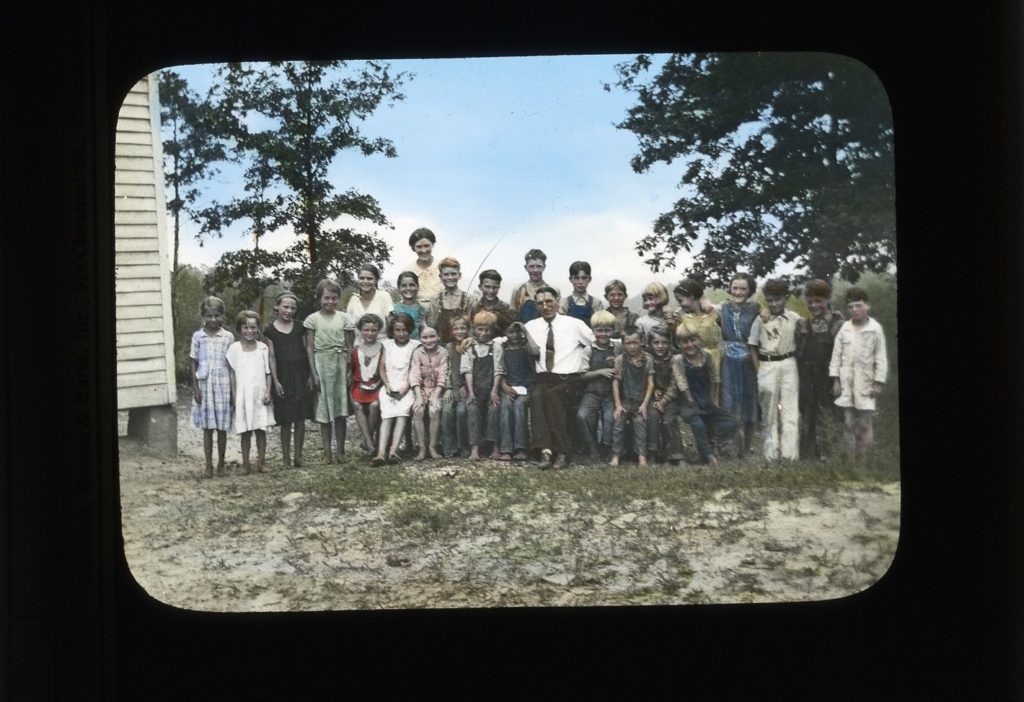Last year, while watching Ashley York and Sally Rubin’s film Hillbilly about mainstream representations of Appalachia, I was struck by how much of my self-identification and perspective of Appalachia was formed not by my friends, family, neighbors, and communities, but by outside perceptions and depictions of Appalachia.

Hillbilly “introduces audiences to a nuanced, authentic Appalachia that is quite conscious of how it has been portrayed and the impacts of those portrayals,” according to its creators.
At the same time, I was curating an exhibition with the help of three local photographers concerning the glass lantern slide photographs of a missionary circuit preacher working in Eastern Kentucky from the 1930s through the 1960s. Again, I had to contend with how outside perceptions of a region can impact self-identification, since the photographs he took were then used in sermons and lectures he delivered in Sunday schools.

A hand-tinted glass lantern slide photograph of a Sunday school taught by J.A. Stafford, of Berea, Ky.
By the time I came to Foxfire, cognizant and critical of these perceptions of Appalachia, I still had little experience of the alternative: representations of Appalachians by Appalachians. If you are reading this, you know the first place to look. It is here, at Foxfire, where local students photographed, interviewed, recorded, transcribed, described, preserved, built and rebuilt core aspects of Southern Appalachian culture. They did it by talking to their family, neighbors, and local experts, and by putting into use the unique curiosity, insight, and vigor of youth.
At Foxfire, I have helped preserve the archive’s immense collection of photographs by transferring negatives into new sleeves and binders. This will hopefully keep the images around a little while longer, and will make it easier for Foxfire staff and students to share these images with all of you through Foxfire books, magazines, and social media. The photographs document many homesteading ways and traditional skills of southern Appalachia. Due to organizations like Foxfire that have worked since the 1960s to save these traditions, people around the country and the world have picked up skills such as weaving, blacksmithing, and woodstove cooking that might have otherwise been lost without their advocacy. The photography of Foxfire students has been a key component of this advocacy since its beginning in 1966.
However, there is a less practical and more emotional significance towards preserving the thousands of photographs and negatives at Foxfire, like when the family of long-departed relatives are searching for remembrances of their loved ones, and recall they were interviewed by Foxfire. Students routinely captured portrait photographs for the magazine. When looking up biographical details on a contact, it is not uncommon to find photographs taken by Foxfire students in obituaries or on genealogy websites. Foxfire contacts seem to come alive again when seen working at a forge, farming with a mule-drawn plow, or cooking over a stove.
While developing the mobile tour app (which you should soon be able to use!) I realized the need for conversation even as technology seems to threaten it. Google could not answer all my questions regarding animal-drawl agricultural tools, barn architecture, weather prediction, gunsmithing, or hog scalding. For that, I turned to interviews by Foxfire students. But I also turned to conversations with my own relatives, who recalled using turning plows, hand seeders, and corn cribs. I talked to my grandparents about growing their food before they owned a tractor. I talked to my father about the importance of rifles in homesteading, and the great technical skill necessary to become a gunsmith. I talked to my great uncle about my ancestor’s grist mill.
These conversations are the best part of visiting Foxfire. When you walk through the museum on a busy day, take the opportunity to eavesdrop a little. You will learn not only about Foxfire’s collection of artifacts and the history of Southern Appalachia, but the individual and family histories that make it worth preserving. I hope you will use the upcoming mobile tour app to facilitate more conversations with friends, family, and strangers about your own past and identities as they relate to Appalachia.
~Charlsa Hensley

We visited Foxfire while Charlsa was there. I had read the first Foxfire books years ago and was fascinated with the history of everyday living I found there. This article expresses what I also felt with the first of the Foxfire books…a reverence for those who “made history” before we were on the scene.